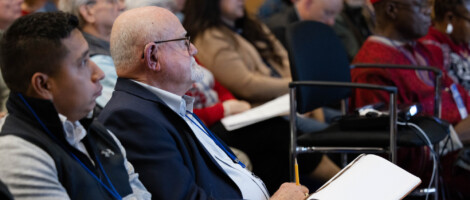Church revitalization takes time, refocus on the basics, Smith says during Annual Meeting workshop
by Teresa Young on November 15, 2022 in Annual Meeting

On Tuesday morning, Jonathan Smith, director of Church Health Strategy at Texas Baptists, led a workshop focused on church revitalization at the 2022 Annual Meeting. The workshop looked at ways churches can kickstart revitalization in their own, unique contexts.
Smith spoke about a new program called PAVE: New Paths for Church Growth, that his ministry offers. The program is a resource for churches, providing one-on-one coaching and consultation for pastors as they lead the effort to revitalize their congregation. He shared steps to starting the process that have proven successful for several Texas Baptists pastors, as well as Smith himself.
“Revitalization is returning to discipleship, evangelism, missions, prayer and church planting. It’s the autonomous work of the local church with little to no outside influence or funding,” Smith said. “I can explain revitalization with one word: New. It’s about starting things that are new.”
Smith warned that churches struggle with change, and that time is essential to revitalize a church. He also said that pastors should be careful not to overlook important details in a sense of urgency as they must build trust in the congregation to truly succeed.
Smith encouraged church leaders to start by taking a quick “snapshot” of their church, which Smith defined as the age of the church; the percentage of church members age 65+ and 18 and under; the tenure of the pastor; and the pastoral influence. Then, pastors should begin the process with the following steps:
Present a truthful picture of the church and the possibility of what could be. He suggested utilizing the Annual Church Profile (ACP) 10-year report, which is available from the convention, the church life cycle analysis and the Know Your Church Report as instruments to create a clear picture of reality. That includes, Smith urged, a look at attendance and baptism patterns, budget trends and a demographic study of the community surrounding the church.
Re-engage with the community through a set of seven interviews with key leaders. This, says Smith, will help identify areas where the church can practically serve its community and be a resource These leaders can include teachers, doctors, other pastors or local elected officials... Ask them about pressing issues in the community and how the church can help.
Raise the morale of the congregation. In most cases, Smith said this involves celebrating even the smallest wins to start momentum, using member testimonies and starting mission efforts to encourage others. He said that baptisms can be a powerful time to celebrate the faithfulness of God.
Display the church you need to become. Smith suggested that members of all ages should be actively serving in front-facing ministry, such as worship team or greeters, so that people feel welcome.
Smith concluded that ultimately, a refocus on evangelism and reaching the lost for Christ is the key to reviving a church. Pastors should be careful not to focus on attendance numbers solely, he says, since growth is a reflection of kingdom progress.
Ultimately, Smith reminded workshop attendees that the gospel is the center of the process and following that will help everything else fall into place.
“Your church is not in competition against another church in your community. Your competition is against the darkness,” Smith said. “The greatest revival we could see is that people will come to faith in Jesus, and that’ll turn the hearts of a congregation faster than anything else.”
Texas Baptists is a movement of God’s people to share Christ and show love by strengthening churches and ministers, engaging culture and connecting the nations to Jesus.
The ministry of the convention is made possible by giving through the Texas Baptists Cooperative Program, Mary Hill Davis Offering® for Texas Missions, Texas Baptists Worldwide and Texas Baptist Missions Foundation. Thank you for your faithful and generous support.
Subscribe to receive stories like this one directly to your inbox.
We are more together.
Read more articles in: Annual Meeting, Church Health, Church Health & Growth
More from Teresa Young
- Marriott says Great Commandment, Great Commission task ‘requires great unity’
- Intercultural ministries celebrate God’s work to the nations in Texas
- Pastors share impact of PAVE program during Annual Meeting Workshop
- Texas Baptist Missions Foundation celebrates student ministry, capital campaign
- Texas Baptists en Español rally celebrates pastors, opportunity to follow Jesus’ agenda